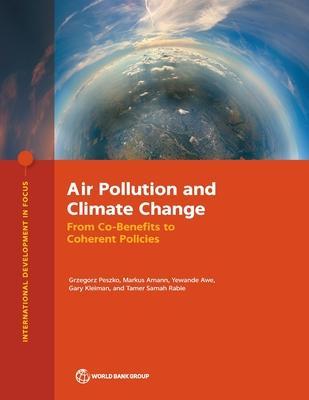Air Pollution and Climate Change

Air Pollution and Climate Change
Achieving carbon neutral development will involve a roughly 40-year-long structural transformation, especially in developing and emerging economies, where most people exposed to poor air quality live. In the meantime, 6+"7 million people die each year by breathing polluted air. But does climate action always lead to better air quality? Likewise, do air pollution policies always lead to cooler climate? The answers are not always clear. For example, while short-lived climate pollutants contribute to air pollution, some important air pollutants cool the climate with equal countervailing force. Retrofitting coal-fired power plants with modern air pollution filters can quickly reduce most air pollution but slightly increases carbon emissions. In the absence of effective carbon pricing, this can also lock in carbon-intensive installations for decades. On the other hand, putting a price on carbon in the absence of effective air quality policies can encourage firms to switch off air pollution filters. Carbon pricing can also push lower-income households to use biomass and waste instead of gas, electricity, or district heating for cooking and heating, increasing population exposure to air pollution. These tensions do not justify inaction on any of these major market failures. But neither of these environmental problems can be solved effectively by pursuing one-sided environmental policy. This report brings much needed realism to climate and air pollution debate. It analyzes international experience to identify effective pathways to coherent policy packages that harness synergies and manage inevitable tensions between climate mitigation and air-quality management. It helps decision makers prioritize pollutants and emission sources and implement regulations that will encourage economic actors to implement technical and behavioral measures in a way that quickly saves people's lives while navigating the longer journey to a low-carbon future.
PRP: 277.43 Lei
Acesta este Prețul Recomandat de Producător. Prețul de vânzare al produsului este afișat mai jos.
249.69Lei
249.69Lei
277.43 LeiIndisponibil
Descrierea produsului
Achieving carbon neutral development will involve a roughly 40-year-long structural transformation, especially in developing and emerging economies, where most people exposed to poor air quality live. In the meantime, 6+"7 million people die each year by breathing polluted air. But does climate action always lead to better air quality? Likewise, do air pollution policies always lead to cooler climate? The answers are not always clear. For example, while short-lived climate pollutants contribute to air pollution, some important air pollutants cool the climate with equal countervailing force. Retrofitting coal-fired power plants with modern air pollution filters can quickly reduce most air pollution but slightly increases carbon emissions. In the absence of effective carbon pricing, this can also lock in carbon-intensive installations for decades. On the other hand, putting a price on carbon in the absence of effective air quality policies can encourage firms to switch off air pollution filters. Carbon pricing can also push lower-income households to use biomass and waste instead of gas, electricity, or district heating for cooking and heating, increasing population exposure to air pollution. These tensions do not justify inaction on any of these major market failures. But neither of these environmental problems can be solved effectively by pursuing one-sided environmental policy. This report brings much needed realism to climate and air pollution debate. It analyzes international experience to identify effective pathways to coherent policy packages that harness synergies and manage inevitable tensions between climate mitigation and air-quality management. It helps decision makers prioritize pollutants and emission sources and implement regulations that will encourage economic actors to implement technical and behavioral measures in a way that quickly saves people's lives while navigating the longer journey to a low-carbon future.
Detaliile produsului










